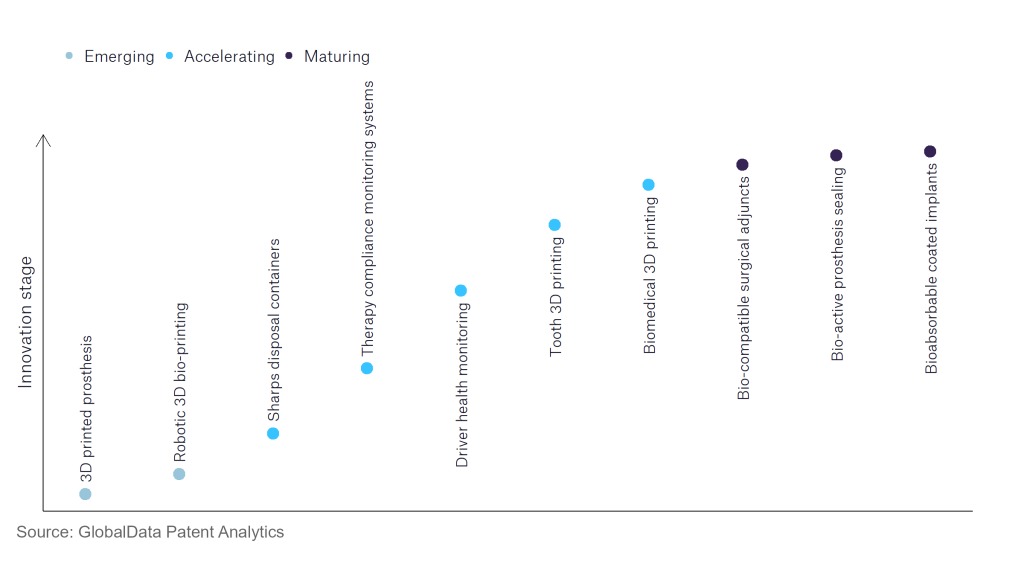The medical devices industry continues to be a hotbed of innovation, with activity driven by increased need for homecare, preventative treatments, early diagnosis, reducing patient recovery times and improving outcomes, as well as a growing importance in technologies such as machine learning, augmented reality, 5G and digitalization. In the last three years alone, there have been over 450,000 patents filed and granted in the medical devices industry, according to GlobalData’s report on Environment Sustainability in Medical Devices: Biomedical 3D Printing.
However, not all innovations are equal and nor do they follow a constant upward trend. Instead, their evolution takes the form of an S-shaped curve that reflects their typical lifecycle from early emergence to accelerating adoption, before finally stabilising and reaching maturity.
Identifying where a particular innovation is on this journey, especially those that are in the emerging and accelerating stages, is essential for understanding their current level of adoption and the likely future trajectory and impact they will have.
150+ innovations will shape the medical devices industry
According to GlobalData’s Technology Foresights, which plots the S-curve for the medical devices industry using innovation intensity models built on over 550,000 patents, there are 150+ innovation areas that will shape the future of the industry.
Within the emerging innovation stage, robotic 3D bio-printing and 3D printed prosthesis are disruptive technologies that are in the early stages of application and should be tracked closely. Sharps disposal containers, biomedical 3D printing, and tooth 3D printing are some of the accelerating innovation areas, where adoption has been steadily increasing. Among maturing innovation areas are bio-compatible surgical adjuncts and bio-active prosthesis sealing, which are now well established in the industry.
Innovation S-curve for environment sustainability in the medical devices industry

Biomedical 3D printing is a key innovation area in environment sustainability
Biomedical 3D printing is the process of creating a 3D replica of products matching the patient’s anatomy, based on their imaging data. Also called additive manufacturing, this technology is preferred over traditional methods where products are created through moulding or carving.
Biomedical 3D printing can be used to create objects by placing layers of materials, such as plastics, ceramics, and metal. The manufacturers will be able to make custom objects with the help of magnetic resonance image (MRI) or computer-aided design (CAD) drawings, based on requirements.
GlobalData’s analysis also uncovers the companies at the forefront of each innovation area and assesses the potential reach and impact of their patenting activity across different applications and geographies. According to GlobalData, there are 40+ companies, spanning technology vendors, established medical devices companies, and up-and-coming start-ups engaged in the development and application of biomedical 3D printing.
Key players in biomedical 3D printing – a disruptive innovation in the medical devices industry
‘Application diversity’ measures the number of different applications identified for each relevant patent and broadly splits companies into either ‘niche’ or ‘diversified’ innovators.
‘Geographic reach’ refers to the number of different countries each relevant patent is registered in and reflects the breadth of geographic application intended, ranging from ‘global’ to ‘local’.
Align Technology is one of the leading patent filers in the field of biomedical 3D printing. Some other key patent filers in the field include Carbon and Mitsui Chemicals.
In terms of application diversity, Becton Dickinson leads the pack, followed by Stryker and Orthopaedic Innovation Centre. By means of geographic reach, Stratasys holds the top position, followed by DWS and Berkshire Hathaway in the second and third spots, respectively.
Biomedical 3D printing technology has paved the way to create customized orthopaedic implants, prosthetics, and dental restorations. The demand for this market will continue to increase given the possibility of the technology being used for teaching purposes and producing 3D organs for transplant.
To further understand the key themes and technologies disrupting the medical devices industry, access GlobalData’s latest thematic research report on Medical Devices.
GlobalData, the leading provider of industry intelligence, provided the underlying data, research, and analysis used to produce this article.
GlobalData’s Patent Analytics tracks patent filings and grants from official offices around the world. Textual analysis and official patent classifications are used to group patents into key thematic areas and link them to specific companies across the world’s largest industries.